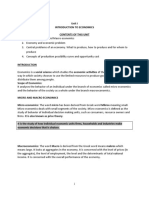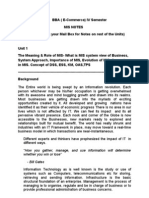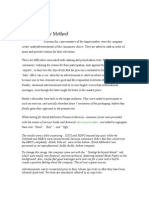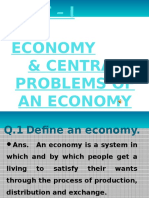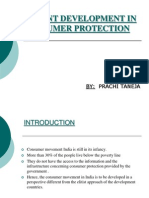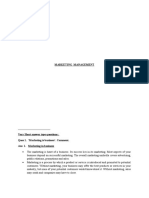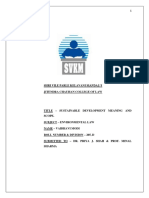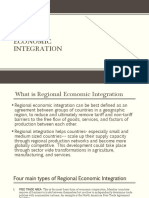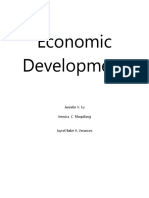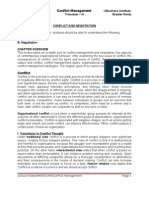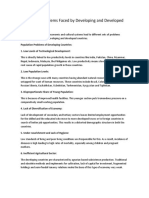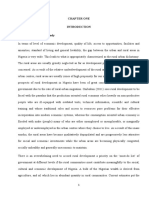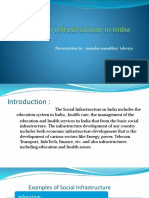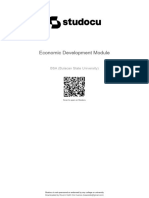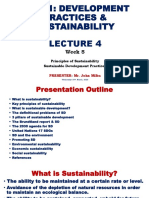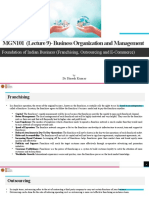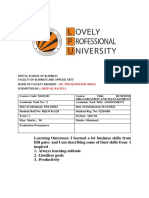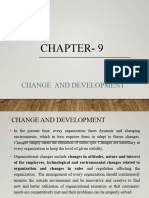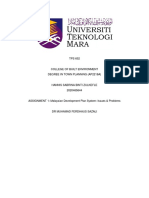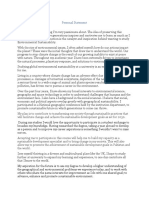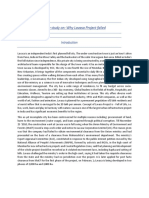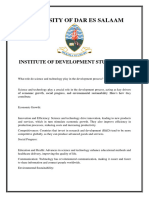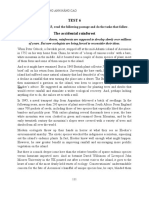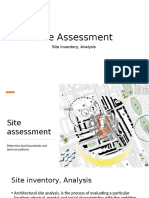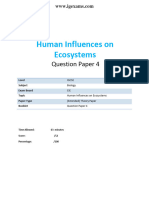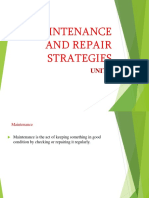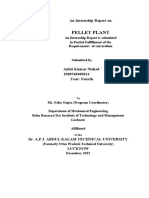Submitted By:: Topic:-The Three Dimensions of Sustainable Development
Submitted By:: Topic:-The Three Dimensions of Sustainable Development
Uploaded by
Karthik Kumar100%(2)100% found this document useful (2 votes)
659 views14 pagesThe three dimensions of sustainable development are the environmental, social, and economic pillars. [1] The social pillar focuses on initiatives that support social issues like healthcare, education, and community development. [2] The economic pillar aims for long-term economic viability while considering environmental and social factors. [3] The environmental pillar involves regulations and tools to manage resources, waste, emissions, water, and land use. Together these three dimensions form the basis of sustainable development.
Original Description:
Original Title
evs ppt
Copyright
© © All Rights Reserved
Available Formats
PPTX, PDF, TXT or read online from Scribd
Share this document
Did you find this document useful?
Is this content inappropriate?
Report this DocumentThe three dimensions of sustainable development are the environmental, social, and economic pillars. [1] The social pillar focuses on initiatives that support social issues like healthcare, education, and community development. [2] The economic pillar aims for long-term economic viability while considering environmental and social factors. [3] The environmental pillar involves regulations and tools to manage resources, waste, emissions, water, and land use. Together these three dimensions form the basis of sustainable development.
Copyright:
© All Rights Reserved
Available Formats
Download as PPTX, PDF, TXT or read online from Scribd
Download as pptx, pdf, or txt
100%(2)100% found this document useful (2 votes)
659 views14 pagesSubmitted By:: Topic:-The Three Dimensions of Sustainable Development
Submitted By:: Topic:-The Three Dimensions of Sustainable Development
Uploaded by
Karthik KumarThe three dimensions of sustainable development are the environmental, social, and economic pillars. [1] The social pillar focuses on initiatives that support social issues like healthcare, education, and community development. [2] The economic pillar aims for long-term economic viability while considering environmental and social factors. [3] The environmental pillar involves regulations and tools to manage resources, waste, emissions, water, and land use. Together these three dimensions form the basis of sustainable development.
Copyright:
© All Rights Reserved
Available Formats
Download as PPTX, PDF, TXT or read online from Scribd
Download as pptx, pdf, or txt
You are on page 1of 14
MITTAL SCHOOL OF BUSINESS
NAME OF THE FACULTY:- Dr. TAUSIF ALTAMASH
TOPIC:- THE THREE DIMENSIONS OF SUSTAINABLE DEVELOPMENT
SUBMITTED BY:
STUDENTS NAME ROLL NO. REGISTRATION NO.
Waghmare Susheel RQOC01A27 12221619
Deepak Maurya RQOC01A28 12216981
Vineet Japra RQOC01A29 12218250
What is sustainable development
Sustainability focuses on meeting the needs
of the present without compromising the ability
of future generations to meet their needs
What Are The Three Pillars Of
Sustainability?
The three pillars of sustainability are the environment, social, and
the economy, those were first mentioned in the
Brundtland report in 1987. Sustainable development is built on top
of those 3 pillars because it can be achieved only when
environmental protection, social equity, and economic profitability
coexist without one area taking over any of the others.
Three pillar of sustainable development
The social , Economic , and environmental
The social
The social pillar refers to initiatives, public policies, planning, and regulations
supporting social issues. These include things such as fighting poverty, social justice,
peace, promoting diversity, quality of living, access to healthcare, education,
community development, cultural heritage, and some aspects of religion.
More in detail, the main aspects of this type of sustainability are:
Peace, security, and human rights are very important components of social
sustainability, this is because wars, crime, and unethical practices are not only
wasting valuable resources in destructive activities but are also ultimately bad for the
environment. Just think about all the pollutants dispersed into the environment during
wars or from factories using unethical practices.
Access to healthcare is a central point of the social principle. Many health-related
issues are interconnected with the environment and economic aspects in general. For
example, in agriculture, green improvements are also helping to improve health-
related conditions. Finally, the World Health Organization is going as far as
considering sustainability impossible to achieve without taking care also of health-
related issues.
Poverty and social justice: poverty and lack of social justice are also not allowing
societies to make long-term plans, ultimately reducing human wellbeing while also
hurting the environment.
Influence of religion and culture: cultural sustainability deals with beliefs, religion,
and heritage conservation. Cultural aspects are without a doubt one of the drivers that
can help to enable sustainable development. In this respect, recent years saw some
important contributions on the religious side that helped to attract more attention to
the topic: with both the Dalai Lama and Pope Francis calling for more responsibility
in fighting ecological degradation and preserving the ecosystems.
Economic
The economic pillar of sustainability is essential for
the business’s existence: a business needs to be
economically viable to be sustainable. At the same
time, a sustainable business should look at
profitability as just one component of the company’s
strategy.
Important points
A conscious business leader aiming at sustainability should
encourage a more balanced culture, where also the social and
environmental factors are taken into consideration together
with profitability and economic sustainability
Keeping in mind the limits of the planet’s resources is key,
especially considering that the current economic model is still
based on “infinite” exponential growth.
Unfortunately, often the limited resources available in the
environment are not factored in: this is the main problem faced
when trying to achieve long-term economic sustainability. There
can’t be long-term economic growth if we deplete all the
available natural resources.
Environmental
The environmental involves regulations, laws, and other tools
used to deal with environmental facts and issues such as the
management of land, freshwater, oceans, forests, air, natural
resources, and wildlife.
The other approach is to manage the demand side of resources
coming from human activities. This involves things such as:
• Waste management: moving away from a linear model (where the
materials end up in a landfill) and promoting a circular path, where
recycling is used as much as possible to harness its benefits.
• Freshwater: efficiency is improved by upgrading infrastructure and
using new green technologies especially in agriculture. Managing also the
demand side, by educating the public on the use of this precious and
limited resource.
• Reducing CO2 emissions: by making extensive use of renewable
sources, improving efficiency, and upgrading to new technologies.
• Cities: proper planning of the urban spaces and infrastructure can help to
achieve more sustainable lifestyles.
Action taken by UNITED NATION
The Sustainable Development Agenda
17 Goals for People, for Planet
The Sustainable Development Goals are a universal call to
action to end poverty, protect the planet and improve the lives
and prospects of everyone, everywhere. The 17 Goals were
adopted by all UN Member States in 2015, as part of the
2030 Agenda for Sustainable Development which set out a
15-year plan to achieve the Goals.
Today, progress is being made in many places, but, overall,
action to meet the Goals is not yet advancing at the speed or
scale required. 2020 needs to usher in a decade of ambitious
action to deliver the Goals by 2030.
Image is taken by UN website
THANK YOU
You might also like
- Constructing Sustainable Tourism Development: The 2030 Agenda and The Managerial Ecology of Sustainable TourismDocument18 pagesConstructing Sustainable Tourism Development: The 2030 Agenda and The Managerial Ecology of Sustainable TourismNathalia Iqbal0% (1)
- Analyzing The Sustainability of Community Driven Development in Afghanistan Using The National Solidarity Program Case StudyDocument45 pagesAnalyzing The Sustainability of Community Driven Development in Afghanistan Using The National Solidarity Program Case StudyInternationalDevelopment100% (3)
- Pradhan Mantri Mudra Yojana: A New Financial Inclusion InitiativeDocument5 pagesPradhan Mantri Mudra Yojana: A New Financial Inclusion Initiativekarthick50% (2)
- Sustainable Development GoalsDocument44 pagesSustainable Development GoalsSaira MansabNo ratings yet
- PRELIM Business Ethics With Good GovernaceDocument10 pagesPRELIM Business Ethics With Good Governacepark se yeonNo ratings yet
- Pre-Independence Extension and Rural Development ProgrammesDocument9 pagesPre-Independence Extension and Rural Development ProgrammesDaizie SancleyNo ratings yet
- Training Program On Capturing Gender Equality Results in ADB Operations - AgendaDocument2 pagesTraining Program On Capturing Gender Equality Results in ADB Operations - AgendaADBGAD100% (1)
- Poverty PPT by Vipin BansalDocument24 pagesPoverty PPT by Vipin BansalVipin BansalNo ratings yet
- Drivers of Corporate Social ResponsibilityDocument4 pagesDrivers of Corporate Social ResponsibilityDiana Rose Dalit100% (1)
- Micro Economics NotesDocument18 pagesMicro Economics NotesRonak SudhirNo ratings yet
- Retail Mcqs 19 20 Batch PDFDocument26 pagesRetail Mcqs 19 20 Batch PDFShailendra JoshiNo ratings yet
- DS 102 Seminar 2023 24Document2 pagesDS 102 Seminar 2023 24benivorentpeterNo ratings yet
- Social Planning Mock ExamDocument28 pagesSocial Planning Mock ExamReymond IgayaNo ratings yet
- Economic Development Complete NotesDocument36 pagesEconomic Development Complete Notessajad ahmad100% (1)
- BBA Sem 4 MIS Notes Unit OneDocument23 pagesBBA Sem 4 MIS Notes Unit OneAbhishek AryaNo ratings yet
- MCQ Dcs 3Document7 pagesMCQ Dcs 3Christopher JakeNo ratings yet
- Consumer Jury MethodDocument4 pagesConsumer Jury MethodVishesh JaiswalNo ratings yet
- UNIT-I - ECONOMY & CENTRAL PROBLEM Powerpoint Presentation (Repaired)Document75 pagesUNIT-I - ECONOMY & CENTRAL PROBLEM Powerpoint Presentation (Repaired)cpawan_699508100% (4)
- Rural Markets and Factors Affecting Rural MarketsDocument30 pagesRural Markets and Factors Affecting Rural MarketsSucharita SarkarNo ratings yet
- A Study On Socio-Economic Status of Women Sanitary WorkersDocument34 pagesA Study On Socio-Economic Status of Women Sanitary WorkersClassic PrintersNo ratings yet
- Sustainable Development Aditya SharmaDocument9 pagesSustainable Development Aditya SharmaAditya Sharma0% (1)
- Environmental Assessment Preparing For New VentureDocument22 pagesEnvironmental Assessment Preparing For New VentureAftab AhmedNo ratings yet
- Rural: EntrepreneurshipDocument7 pagesRural: EntrepreneurshipRupesh kumar mishraNo ratings yet
- Recent Deveopment in Consumer ProtectionDocument18 pagesRecent Deveopment in Consumer ProtectionPrachee Chelsea Taneja100% (3)
- Corporate Social Responsibility: Case Studies OnDocument31 pagesCorporate Social Responsibility: Case Studies OnJIRRARAJIV100% (1)
- MCQ - Urban EconomicsDocument20 pagesMCQ - Urban EconomicsAr Debapriya100% (1)
- Esd QuizDocument12 pagesEsd QuizMAE ANGELESNo ratings yet
- Chapter 11 - Marketing - 1.3 Notes PDFDocument26 pagesChapter 11 - Marketing - 1.3 Notes PDFANUJ SHARMANo ratings yet
- Classification of IndustriesDocument11 pagesClassification of IndustriesAppan Kandala Vasudevachary100% (3)
- Innovation Management NotesDocument4 pagesInnovation Management NotesMohd Izzudin100% (1)
- Agriculture and Non-Agriculture SectorsDocument12 pagesAgriculture and Non-Agriculture SectorsAkansha MehtaNo ratings yet
- Indian Economic EnvironmentDocument20 pagesIndian Economic EnvironmentSayak Goswami100% (2)
- Five Year PlanDocument2 pagesFive Year PlanJeyarajasekar TtrNo ratings yet
- Regional PlanningDocument9 pagesRegional Planningkomal100% (3)
- Marketing Management Question Bank 2Document28 pagesMarketing Management Question Bank 2jatinder99No ratings yet
- Chapter One Office ManagementDocument29 pagesChapter One Office Managementm_alodat6144100% (1)
- Sustainable Development Meaning and Scope PDFDocument12 pagesSustainable Development Meaning and Scope PDFVaibhavi Modi100% (1)
- Regional Economic IntegrationDocument15 pagesRegional Economic IntegrationKaechelle Marie MorilloNo ratings yet
- Chapter 8 - Economic DevelopmentDocument17 pagesChapter 8 - Economic DevelopmentJaycel Yam-Yam VerancesNo ratings yet
- SocialWorkin WPS OfficeDocument16 pagesSocialWorkin WPS OfficeNasrimah DitaNo ratings yet
- POVERTY PPT 14Document76 pagesPOVERTY PPT 14Shubhankar ThakurNo ratings yet
- MFS MCQDocument11 pagesMFS MCQAbrar SangeNo ratings yet
- Lecture 1 Theories and Concepts in Rural DevelopmentDocument37 pagesLecture 1 Theories and Concepts in Rural Developmentalogngo100% (4)
- Lecture Notes - Conflict Mgt. - 2Document8 pagesLecture Notes - Conflict Mgt. - 2ramandubey0% (1)
- Main Objectives of Fiscal Policy in IndiaDocument4 pagesMain Objectives of Fiscal Policy in Indiasadathnoori0% (1)
- Unit-3 Small-Scale-IndustriesDocument111 pagesUnit-3 Small-Scale-IndustriesKunal GoelNo ratings yet
- Syllabus of IR BBA-IVDocument4 pagesSyllabus of IR BBA-IVhizbullah chandioNo ratings yet
- INDIAN BUSINESS ENVIRONMENT 1st UniTDocument37 pagesINDIAN BUSINESS ENVIRONMENT 1st UniThahaha@hehe88% (17)
- Population Problems Faced by Developing and Developed CountriesDocument3 pagesPopulation Problems Faced by Developing and Developed CountriesSalvador ValdizonNo ratings yet
- Activity Areas of HRDDocument16 pagesActivity Areas of HRDDrPurnima SharmaNo ratings yet
- Notes Conflict ResolutionDocument9 pagesNotes Conflict ResolutionNeha BhatiaNo ratings yet
- Planning Theory PPT (Impediments To Public Participation)Document16 pagesPlanning Theory PPT (Impediments To Public Participation)Sanjay KumarNo ratings yet
- The Role of NGO in Community DevelopmentDocument68 pagesThe Role of NGO in Community DevelopmentSAMAILA BITRUSNo ratings yet
- Business Environment - Case Studies QuesDocument13 pagesBusiness Environment - Case Studies QuesKing KongNo ratings yet
- 4-Ppt On Social ResponsibilityDocument32 pages4-Ppt On Social ResponsibilityBinkleNo ratings yet
- Social InfrastructureDocument16 pagesSocial InfrastructureHetvi KhyaliNo ratings yet
- Economic Development ModuleDocument42 pagesEconomic Development ModuleRovern Keith Oro Cuenca100% (1)
- Sustainable Development: San Carlos CollegeDocument13 pagesSustainable Development: San Carlos CollegeArya Guzman82% (11)
- CD 111 Lecture 4 Week 5 (Mar 15th, 2023)Document26 pagesCD 111 Lecture 4 Week 5 (Mar 15th, 2023)Amos KewaNo ratings yet
- 02 Green Skills II Revision NotesDocument4 pages02 Green Skills II Revision Notesadityasharma6261srNo ratings yet
- Lect9 - Business Organisationand ManagementDocument11 pagesLect9 - Business Organisationand ManagementKarthik KumarNo ratings yet
- 2.sustainable DevelopmentDocument19 pages2.sustainable DevelopmentKarthik KumarNo ratings yet
- Lean Manufacturing Competitiveness For MsmesDocument4 pagesLean Manufacturing Competitiveness For MsmesKarthik KumarNo ratings yet
- Academic Task 1Document2 pagesAcademic Task 1Karthik KumarNo ratings yet
- Lect21-23 MGN101 - TheoriesDocument11 pagesLect21-23 MGN101 - TheoriesKarthik KumarNo ratings yet
- MGN101 Ca2Document14 pagesMGN101 Ca2Karthik KumarNo ratings yet
- CA 3 TemplateDocument5 pagesCA 3 TemplateKarthik KumarNo ratings yet
- MGN100M Ca3Document5 pagesMGN100M Ca3Karthik KumarNo ratings yet
- Chapter 9 Change and DevelomentDocument30 pagesChapter 9 Change and DevelomentYosef TsegayeNo ratings yet
- Significance of The StudyDocument2 pagesSignificance of The StudyMiguel VienesNo ratings yet
- Biology Assignment 1Document3 pagesBiology Assignment 1Johanna HaludiluNo ratings yet
- Oil Fired Furnace PDFDocument2 pagesOil Fired Furnace PDFmool rajNo ratings yet
- Hannis Sabrina Binti Zulkefle 2020465644 Malaysian Development Plan Issues and ProblemDocument5 pagesHannis Sabrina Binti Zulkefle 2020465644 Malaysian Development Plan Issues and ProblemHANNIS SABRINA ZULKEFLENo ratings yet
- The Modification of Barangay Halls in The Philippines: An Architectural Design Made For The Betterment of A CommunityDocument8 pagesThe Modification of Barangay Halls in The Philippines: An Architectural Design Made For The Betterment of A CommunityJimin ParkNo ratings yet
- Personal StatementDocument1 pagePersonal StatementTehreem Afzaal100% (1)
- Yeni Model 11 Ci Sinif Sinaqlari - 2Document3 pagesYeni Model 11 Ci Sinif Sinaqlari - 2Kəmalə HüseynovaNo ratings yet
- GodIzv 2020Document31 pagesGodIzv 2020Деан ВеселиновићNo ratings yet
- Philiri Booklet Grade 6 Pre-TestDocument18 pagesPhiliri Booklet Grade 6 Pre-TestMaria Carmela FornolesNo ratings yet
- Water Distribution System DesignDocument21 pagesWater Distribution System DesignCrazyBookWorm100% (1)
- Case Study On - Why Lavasa Project FailedDocument10 pagesCase Study On - Why Lavasa Project FailedPUSPENDRA RANA100% (1)
- 10 Unbelievable Facts About The OceanDocument5 pages10 Unbelievable Facts About The OceanMiclaxNo ratings yet
- Wellington Firewood Collection Areas For 2023Document2 pagesWellington Firewood Collection Areas For 2023tylerbottegaNo ratings yet
- LecturePlan AN203 21UCT-294Document5 pagesLecturePlan AN203 21UCT-294Aditya kumar GuptaNo ratings yet
- AFB PPRC - 25 9-Proposal-for-Pakistan PDFDocument214 pagesAFB PPRC - 25 9-Proposal-for-Pakistan PDFRehman BaberNo ratings yet
- DS 2024 PDFDocument8 pagesDS 2024 PDFkasasewilsonNo ratings yet
- READING PRACTICE TESTS FOR NEC 1 REVISED - Test 6Document13 pagesREADING PRACTICE TESTS FOR NEC 1 REVISED - Test 67A323Trọng NhânNo ratings yet
- Cambridge International AS & A Level: GEOGRAPHY 9696/32Document4 pagesCambridge International AS & A Level: GEOGRAPHY 9696/32VenonNo ratings yet
- Xu Et Al. 2019 - Supply Chain Sustainability Risk and AssessmentDocument11 pagesXu Et Al. 2019 - Supply Chain Sustainability Risk and AssessmentAlwi SalamNo ratings yet
- AMONIANTODocument3 pagesAMONIANTOCarlos Andres BulaNo ratings yet
- SITE ASESSMENT Site Inventory AnalysisDocument18 pagesSITE ASESSMENT Site Inventory AnalysisJoyce NolosNo ratings yet
- Human - Influences - On - Ecosystems - 4 QPDocument5 pagesHuman - Influences - On - Ecosystems - 4 QPkatise1794No ratings yet
- Maintenance and Repair Strategies: Unit 1Document34 pagesMaintenance and Repair Strategies: Unit 1selvaNo ratings yet
- 0011 Social Sub-Sector - Housing - Part 1 (3731)Document27 pages0011 Social Sub-Sector - Housing - Part 1 (3731)John EstremeraNo ratings yet
- HAL Internship ReportDocument17 pagesHAL Internship Reportramjanam nishadNo ratings yet
- Fuschi Et Al 2022 Microplastics in The Great Lakes Environmental Health and Socioeconomic Implications and FutureDocument18 pagesFuschi Et Al 2022 Microplastics in The Great Lakes Environmental Health and Socioeconomic Implications and FuturecriscazanNo ratings yet
- ôn tập unit 4Document5 pagesôn tập unit 423520066No ratings yet
- Fahrig - 2019 - Habitat Fragmentation A Long and Tangled TaleDocument9 pagesFahrig - 2019 - Habitat Fragmentation A Long and Tangled TaleGabriela Reyes PalomequeNo ratings yet









